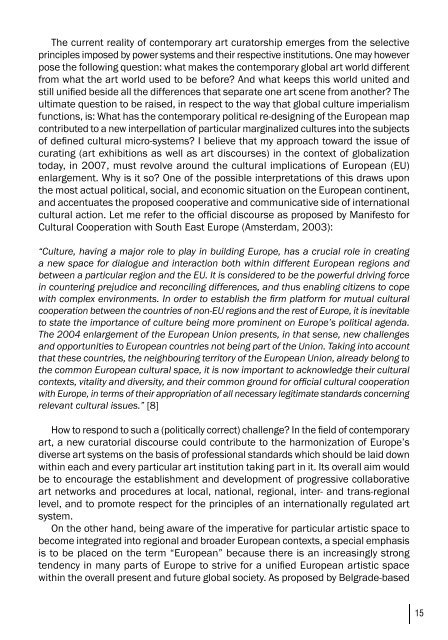art-e-conomy _ reader - marko stamenkovic
art-e-conomy _ reader - marko stamenkovic
art-e-conomy _ reader - marko stamenkovic
Create successful ePaper yourself
Turn your PDF publications into a flip-book with our unique Google optimized e-Paper software.
The current reality of contemporary <strong>art</strong> curatorship emerges from the selective<br />
principles imposed by power systems and their respective institutions. One may however<br />
pose the following question: what makes the contemporary global <strong>art</strong> world different<br />
from what the <strong>art</strong> world used to be before? And what keeps this world united and<br />
still unified beside all the differences that separate one <strong>art</strong> scene from another? The<br />
ultimate question to be raised, in respect to the way that global culture imperialism<br />
functions, is: What has the contemporary political re-designing of the European map<br />
contributed to a new interpellation of p<strong>art</strong>icular marginalized cultures into the subjects<br />
of defined cultural micro-systems? I believe that my approach toward the issue of<br />
curating (<strong>art</strong> exhibitions as well as <strong>art</strong> discourses) in the context of globalization<br />
today, in 2007, must revolve around the cultural implications of European (EU)<br />
enlargement. Why is it so? One of the possible interpretations of this draws upon<br />
the most actual political, social, and economic situation on the European continent,<br />
and accentuates the proposed cooperative and communicative side of international<br />
cultural action. Let me refer to the official discourse as proposed by Manifesto for<br />
Cultural Cooperation with South East Europe (Amsterdam, 2003):<br />
“Culture, having a major role to play in building Europe, has a crucial role in creating<br />
a new space for dialogue and interaction both within different European regions and<br />
between a p<strong>art</strong>icular region and the EU. It is considered to be the powerful driving force<br />
in countering prejudice and reconciling differences, and thus enabling citizens to cope<br />
with complex environments. In order to establish the firm platform for mutual cultural<br />
cooperation between the countries of non-EU regions and the rest of Europe, it is inevitable<br />
to state the importance of culture being more prominent on Europe’s political agenda.<br />
The 2004 enlargement of the European Union presents, in that sense, new challenges<br />
and opportunities to European countries not being p<strong>art</strong> of the Union. Taking into account<br />
that these countries, the neighbouring territory of the European Union, already belong to<br />
the common European cultural space, it is now important to acknowledge their cultural<br />
contexts, vitality and diversity, and their common ground for official cultural cooperation<br />
with Europe, in terms of their appropriation of all necessary legitimate standards concerning<br />
relevant cultural issues.” [8]<br />
How to respond to such a (politically correct) challenge? In the field of contemporary<br />
<strong>art</strong>, a new curatorial discourse could contribute to the harmonization of Europe’s<br />
diverse <strong>art</strong> systems on the basis of professional standards which should be laid down<br />
within each and every p<strong>art</strong>icular <strong>art</strong> institution taking p<strong>art</strong> in it. Its overall aim would<br />
be to encourage the establishment and development of progressive collaborative<br />
<strong>art</strong> networks and procedures at local, national, regional, inter- and trans-regional<br />
level, and to promote respect for the principles of an internationally regulated <strong>art</strong><br />
system.<br />
On the other hand, being aware of the imperative for p<strong>art</strong>icular <strong>art</strong>istic space to<br />
become integrated into regional and broader European contexts, a special emphasis<br />
is to be placed on the term “European” because there is an increasingly strong<br />
tendency in many p<strong>art</strong>s of Europe to strive for a unified European <strong>art</strong>istic space<br />
within the overall present and future global society. As proposed by Belgrade-based<br />
15


